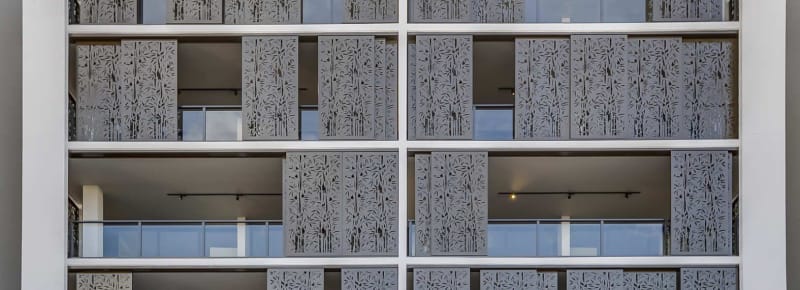Warramoos
Structural
- Sep 19, 2019
- 8
Hi All,
We're reviewing the wind loads on a perforated privacy screen that free spans between the slabs of a building screening off the balconies. The screens are of various porosity and shape. Some screens are movable (i.e slide along the front of the balcony) but most are fixed. Very similar to the photo below.

Our query: Does anyone know or have experience with what wind loading these screens would need to resist. AS/NZS 1170.2 doesn't cover something like this, so we've had to try to come up with something that fits the standard logically, but wondering if there is other literature or "best practice" that others in the industry may be using. A couple of thoughts.
1) We initially considered it as a hoarding or self standing wall, but this doesn't really fit as the free stream wind cant get under or over it. And because there is a wall a couple meters behind it couldn't really get much suction as the free stream wouldn't be traveling fast behind.
2) We're currently considering it to be a cladding. It would only receive windward pressure, and internal pressures would be zero. But would also need to have local pressure coefficients applied to these. We feel confident with this but think its probably extremely conservative, especially as there is no porosity factor on a windward wall in AS1170.2. There is a porosity factor for a hoarding though.
Any thoughts or pointers would be very helpful
Many thanks,
We're reviewing the wind loads on a perforated privacy screen that free spans between the slabs of a building screening off the balconies. The screens are of various porosity and shape. Some screens are movable (i.e slide along the front of the balcony) but most are fixed. Very similar to the photo below.

Our query: Does anyone know or have experience with what wind loading these screens would need to resist. AS/NZS 1170.2 doesn't cover something like this, so we've had to try to come up with something that fits the standard logically, but wondering if there is other literature or "best practice" that others in the industry may be using. A couple of thoughts.
1) We initially considered it as a hoarding or self standing wall, but this doesn't really fit as the free stream wind cant get under or over it. And because there is a wall a couple meters behind it couldn't really get much suction as the free stream wouldn't be traveling fast behind.
2) We're currently considering it to be a cladding. It would only receive windward pressure, and internal pressures would be zero. But would also need to have local pressure coefficients applied to these. We feel confident with this but think its probably extremely conservative, especially as there is no porosity factor on a windward wall in AS1170.2. There is a porosity factor for a hoarding though.
Any thoughts or pointers would be very helpful
Many thanks,



